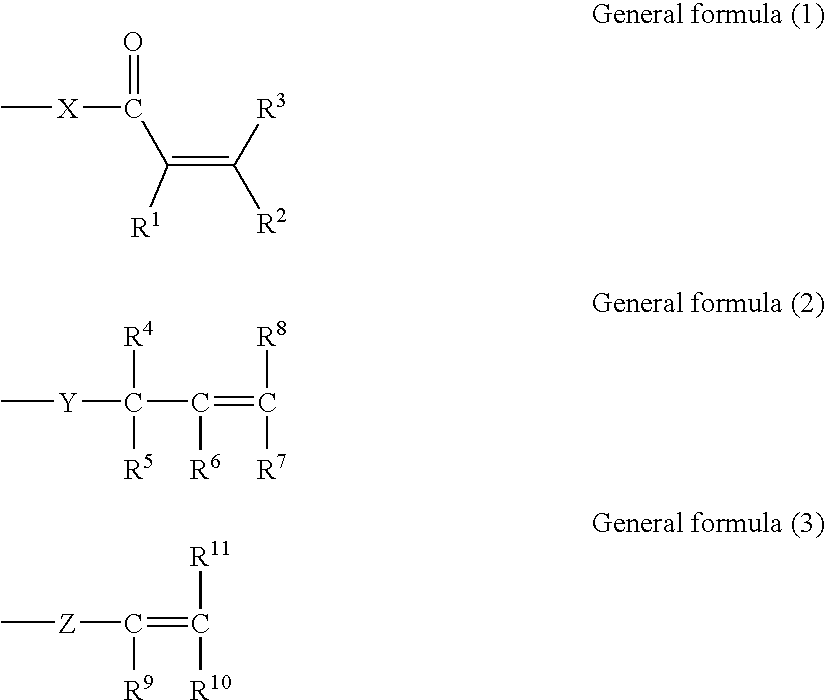Image recording material
- Summary
- Abstract
- Description
- Claims
- Application Information
AI Technical Summary
Benefits of technology
Problems solved by technology
Method used
Image
Examples
synthesis example 1
Synthesis of Polymer Compound (1)
[0067]80 ml of 1-methoxy-2-propanol was put in a 500-ml three-neck flask equipped with a condenser and a stirrer and was heated to 70° C. Under a nitrogen stream, a solution of 53.0 g of the compound (M-1), 5.2 g of methacrylic acid and 0.746 g of V-65 (manufactured by Wako Pure Chemical Industries, Ltd.) in 80 ml of 1-methoxy-2-propanol was added dropwise thereto over 2.5 hours. The mixture was further allowed to react at 70° C. for two hours. After the reaction mixture was diluted with 100 ml of 1-methoxy-2-propanol and cooled to 0° C., 33.4 g of triethylamine was added dropwise while stirring, and the mixture was allowed to react for 12 hours with the temperature being gradually increased to room temperature. After cooling the reaction mixture to 0° C., a 5M HCl was added dropwise to the reaction mixture while stirring until the pH of the reaction mixture reached 6 or less. The reaction mixture was put in 3 L of water to deposit a polymer. The pol...
synthesis example 2
Synthesis of Polymer Compound (2)
[0068]90 ml of methyl ethyl ketone was put in a 500-ml three-neck flask equipped with a condenser and a stirrer and was heated to 70° C. Under a nitrogen stream, a solution of 15.6 g of 2-hydroxyethyl methacrylate, 5.2 g of methacrylic acid, 12.0 g of methyl methacrylate and 0.775 g of V-65 (manufactured by Wako Pure Chemical Industries, Ltd.) in 90 ml of methyl ethyl ketone was added dropwise thereto over 2.5 hours. The mixture was further allowed to react at 70° C. for two hours. After the reaction mixture was cooled to 0° C., 10.9 g of acrylic acid chloride was added dropwise while stirring, and the mixture was allowed to react for 12 hours with the temperature being gradually increased to room temperature. The reaction mixture was put in 3 L of water to deposit a polymer. The polymer was filtered, washed and dried to obtain the polymer compound (2). It was confirmed by NMR spectrum that acrylic groups were introduced to the side chain by a polyme...
synthesis example 3
Synthesis of Polymer Compound (3)
[0069]200 ml of 1-methoxy-2-propanol was put in a 1,000-ml three-neck flask equipped with a condenser and a stirrer and was heated to 70° C. Under a nitrogen stream, a solution of 40.9 g of 2-allyloxyethyl methacrylate, 5.2 g of methacrylic acid and 0.746 g of V-65 (manufactured by Wako Pure Chemical Industries, Ltd.) in 200 ml of 1-methoxy-2-propanol was added dropwise thereto over 2.5 hours. The mixture was further allowed to react at 70° C. for two hours. The reaction mixture was filtered, washed and dried to obtain the polymer compound (3). The weight average molecular weight of the resulting polymer compound was measured by gel permeation chromatography (GPC) using polystyrene as a standard, and found to be 110,000.
PUM
| Property | Measurement | Unit |
|---|---|---|
| Equivalent per mass | aaaaa | aaaaa |
| Fraction | aaaaa | aaaaa |
| Fraction | aaaaa | aaaaa |
Abstract
Description
Claims
Application Information
 Login to View More
Login to View More - R&D
- Intellectual Property
- Life Sciences
- Materials
- Tech Scout
- Unparalleled Data Quality
- Higher Quality Content
- 60% Fewer Hallucinations
Browse by: Latest US Patents, China's latest patents, Technical Efficacy Thesaurus, Application Domain, Technology Topic, Popular Technical Reports.
© 2025 PatSnap. All rights reserved.Legal|Privacy policy|Modern Slavery Act Transparency Statement|Sitemap|About US| Contact US: help@patsnap.com



